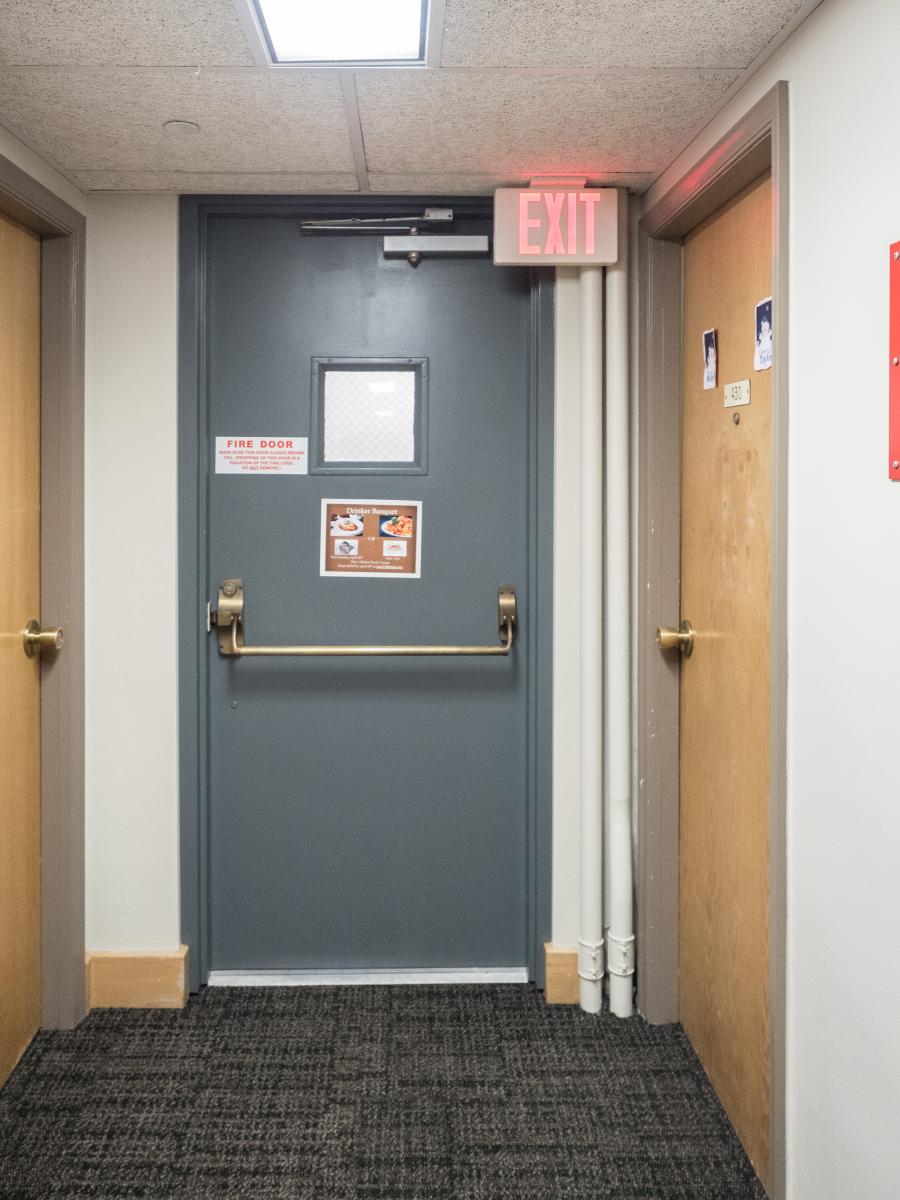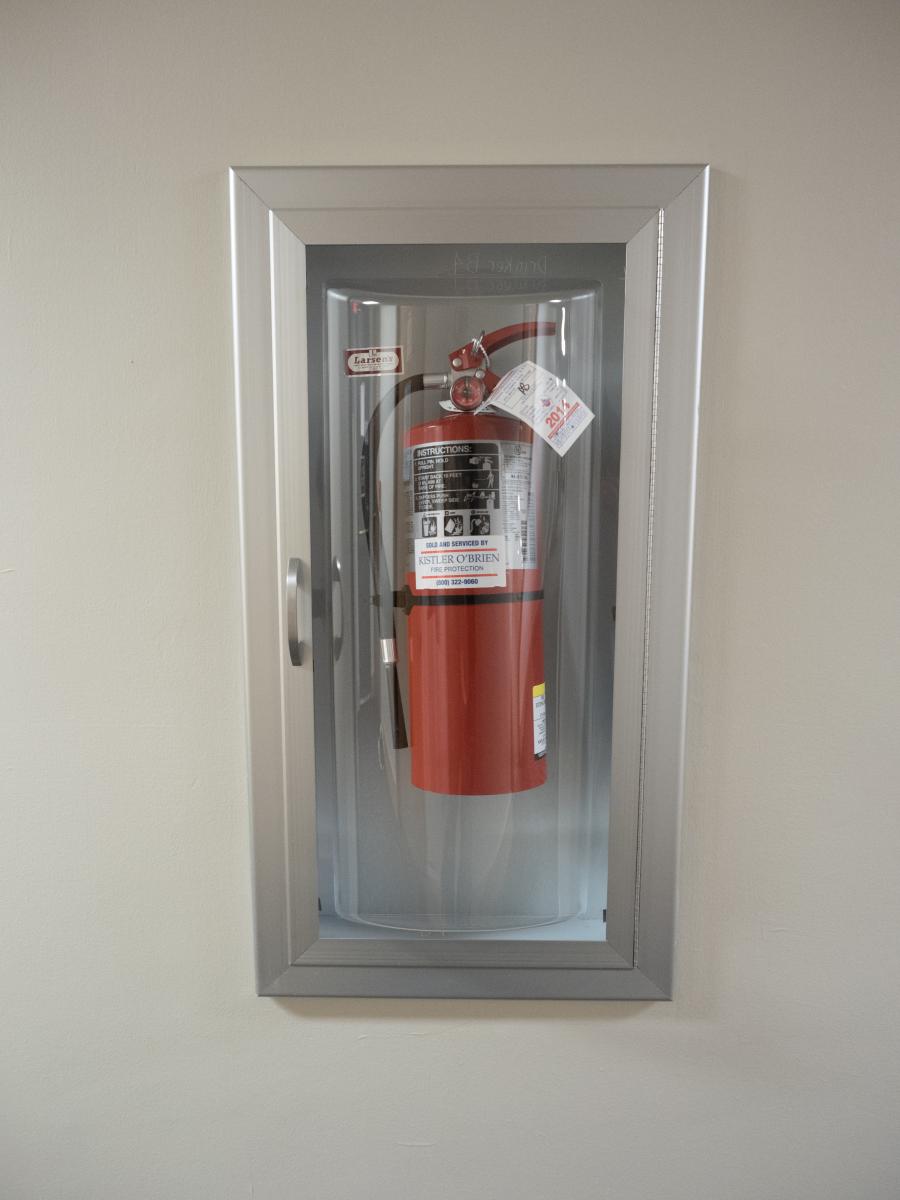 Students should know the following if there is a fire or the fire alarm sounds.
Students should know the following if there is a fire or the fire alarm sounds.
What To Do When Exiting the Building
Your Role After You Have Exited the Building
What To Do When Exiting the Building
- Sound the alarm.
 Exit the building immediately if it safe to do so. Never assume a fire alarm is false or a fire drill. Always exit the building quickly.
Exit the building immediately if it safe to do so. Never assume a fire alarm is false or a fire drill. Always exit the building quickly.- As you exit, consider the following:
- Is there a fire directly outside my door (e.g., warm door handle, visible smoke)?
- No – Exit Immediately.
- Smoke – Crawl to the door and through the hallway. Remain low to the ground.
- Fire - Find a second way out (e.g., your window) or hang something out of your window to bring attention to yourself (e.g., light colored blanket, coat, towel, or sheet).
- Leave window open slightly at bottom to breathe.
- If your phone is working contact University Police (610-758-4200) to let them know where you are located.
- Get fresh air. Make a tent over your head with a blanket at a slightly opened window.
- Do not breathe smoke laden air.
- Do not break the window except to use as an emergency exit.
- Grab your shoes, keys, and coat if necessary.
- Close doors and windows. This slows down the speed that the fire will spread.
- Do not use the elevator if your building if equipped with one.
- Is there a fire directly outside my door (e.g., warm door handle, visible smoke)?
- Do not re-enter the building until you are given permission.
- Where to go after exiting
- In the case of a real fire when students are not allowed to re-enter quickly or will need to be relocated, where should they go?
- Fraternity and Sorority Houses - Lamberton Hall
- Brodhead - Maginnes Hall
- Centennial I - Rathbone Dining Hall
- Centennial II - Rathbone Dining Hall
- Dravo - Lamberton Hall
- Drinker - Lamberton Hall
- Farrington Square - Maginnes Hall
- M&M - Lamberton Hall
- Richards - Rathbone Dining Hall
- Sayre Park - Sayre Park Lodge or Lamberton Hall
- Singleton, Hitch & MAida Houses- Lamberton Hall
- Taylor College - Lamberton Hall
- Trembley Park – Lamberton Hall
- Warren Square - Alumni Memorial Building
- UMOJA – Sayre Park Lodge
- In the case of a real fire when students are not allowed to re-enter quickly or will need to be relocated, where should they go?
Your Role After You Have Exited the Building
 Provide fire safety personnel with any information you may be aware of that would assist them:
Provide fire safety personnel with any information you may be aware of that would assist them:
- The location and size of the fire.
- If there are any students inside the building and where.
- If any students with disabilities remain in the building and where.
- Direct students to a safe location away from the fire.
- Keep students away from the building.
- Remind students to only re-enter the building when they receive permission from the Bethlehem Fire Department and the University Police.
- If media arrive on campus to cover the fire, do not speak to the media. The University will have a representative available to speak to the media.
- If a fire extinguisher was used it needs to be reported immediately to maintenance (610-758-3941) to be refilled.
- Few people are burned to death in fires. Most victims die from smoke, poisonous gases, and panic. If you have an escape plan and adapt it to the emergency, you can greatly increase your chances of survival.
- Evacuation time should be under 3 minutes.
- When the fire department responds to a fire alarm, each fire fighter has one of three roles: clear the building of all people, hook up to the water (fire hydrant), and extinguish the fire.
To help ensure the safety of residents, the following programs are in place:
Fire Drills
Building Walk Thrus
Bedroom Inspections
Facilities Services Preventative Maintenance (e.g., fire extinguisher checks, sprinkler inspections, etc.)
Passive programming (e.g., posters, emails during fire safety month, etc.)
Research and Statistics - Reasons behind the policies
Fires in residential buildings occur all over campus and at all hours of the day and night. In group residential facilities, fires are most likely to occur between 5:00 p.m. – 11:00 p.m. and on weekends. Fatal fires occur…
- off-campus (78%).
- on-campus (11%).
- fraternity/sorority houses (11%).
- academic buildings (1%).
While only 5% of fires occur in bedrooms, these fires are dangerous. Bedroom fires account for 62% of fire deaths and 27% of injuries.
Policy – Bedroom inspections
Statistic - The most common factors in fatal fires are…
- missing/disabled sprinkler system.
- Policy - No items may be hung, wrapped, taped, or otherwise affixed to sprinkler pipes or the sprinkler head. No item in the room may be positioned in such a way as to block the lateral dispersal of water should the sprinkler head be activated. The sprinkler head, if wall mounted, will have no items on the same wall higher than 18 inches below the sprinkler head. This does not include relatively flat items (pictures, posters, etc.) but does include shelving and any objects that may be on the shelving, as well as electrical cords, lights, etc.
- missing/disabled smoke alarm.
- Policy - MAJOR LIFE SAFETY VIOLATION: Smoke detection and suppression equipment has been removed or disabled, preventing its proper function.
- careless disposal of smoking materials.
- Policy - SMOKING POLICY: Students must comply and cooperate with the University smoking policy which states that no person shall smoke or burn tobacco products, hookahs, or any other substance inside any residence hall, suite, or apartment on campus. Smoking is permitted on residential grounds, provided it occurs 15 feet from any building entrance and away from windows of residential facilities.
- alcohol consumption.
- Policy - See the Student Code of Conduct regarding alcohol policies.
Statistic - The most common causes of electrical fires are….
- misuse and poor maintenance of electrical appliances.
- incorrectly installed wiring.
- Policy - DECORATIONS: Decorations must be of a non-combustible and non-permanent nature…
- overloaded circuits and extension cords.
- Policy - All extension cords used must be heavy duty (15 amps) and UL approved.
- Policy - SECONDARY LIFE SAFETY VIOLATION: Multiple electrical devices are connected to one outlet in a hazardous manner.
- Policy - SECONDARY LIFE SAFETY VIOLATION: Non-UL approved electrical devices are connected in any way to the electrical system.
- Policy - MAJOR LIFE SAFETY VIOLATION: Wiring installations made by somebody other than personnel authorized by the University.
- electrical system failures.
- Policy - SECONDARY LIFE SAFETY VIOLATION: An electrical outlet, switch, emergency light, or lighting fixture is deliberately damaged, disabled, or otherwise altered, interfering with its normal function.
- appliance defects.
Statistic - In group residential facilities…
- the leading cause of fire is cooking equipment (75%).
- Policy - PROHIBITED ACTIVITIES: The following activities are not permitted in residential areas…the cooking and preparation of food, except in designated areas…
- each year, candles cause an average of 9400 fires, 90 deaths, 950 injuries, and $120.5 million in losses.
- Policy - FLAMMABLE MATERIALS: Flammable items including candles, chemicals, combustible engines (regardless of their state of dismantlement), gasoline, incense, lighter fluid, and non-electric lanterns are prohibited. Live trees are not permitted.
Statistic - Bedroom fires account for 62% of fire deaths and 27% of injuries.
Policy - DECORATIONS: Decorations must be of a non-combustible and non-permanent nature that will not damage paint or finished surfaces in the room. The only approved adhesive to hang items on the wall are Painter’s tape and Magic Mounts. As stated in fire code regulations, no material or posters may be affixed from the ceiling or overhead at any time. The hanging of cloth material or tapestries may not cover more than 50% of each wall nor can it be hung on a wall above a bed. Curtains which enclose a bed are not permitted. In buildings with sprinkler systems, decorations may be further limited by fire safety regulations. Please refer to section II, 6 for further information.
Policy - The following appliances are not permitted in bedrooms: broilers, coffee makers, electric fry pans, grills/griddles, hot plates, hot pots, microwave ovens, toasters, and toaster ovens.
PROHIBITED ACTIVITIES: The following activities are not permitted in residential areas…playing with fire; chemical experimentation; the cooking and preparation of food, except in designated areas…
STAIRWELLS, EXITS, HALLWAYS: Stairwells, exits, and hallways must remain free and clear of all objects at all times.
- EXTERIOR, FIRE, SECTION, AND ROOM DOORS:
- Exterior, section and fire doors are to remain closed at all times, with exterior doors locked 24-hours a day. Residents of the section will be held responsible when doors are blocked or propped open. A door will be considered propped if there is any physical obstruction (i.e. tape, stones, cardboard, trashcans, etc.) that prevents it from closing and/or locking.
- Student room doors have been equipped with self-closing door hinges to meet fire code regulations. Dismantling or removing self-closing door hinges is prohibited.
- RESTRICTED ITEMS: The possession or use of any potentially dangerous item or material is strictly forbidden. Such items are subject to confiscation. Firearms, fireworks, ammunition, air guns, paint ball guns, spring type weapons, slingshots, martial arts weaponry, explosives, and switchblade or hunting knives are among those items prohibited.
- FIRE DRILLS/ALARMS: When a fire alarm sounds, residents shall vacate the building and cooperate fully with University officials including during fire drills which will be held at regular intervals.
